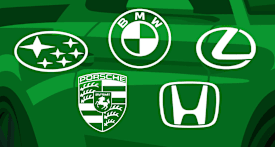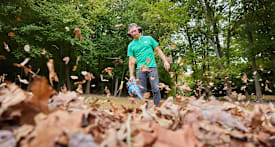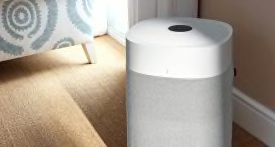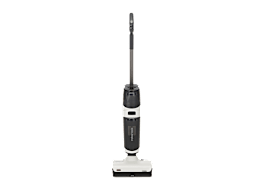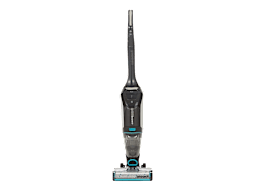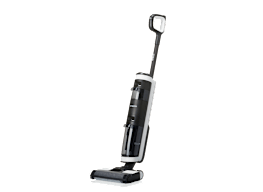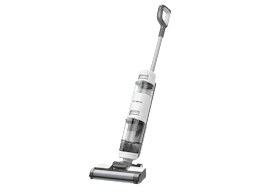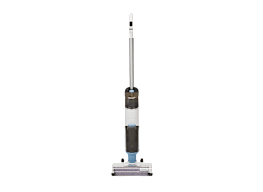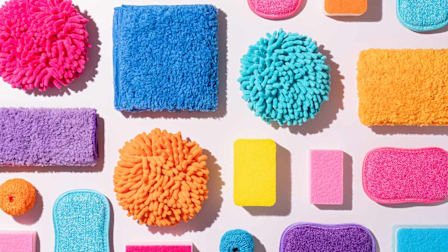We Tried Three Popular Mop Brands to Find Out Which One Is Worth the Hype
I spilled sticky food, drinks, and damp dirt onto three types of floors and used O-Cedar, Scrub Daddy, and Swiffer mops to clean them. Which mop came out on top?

With the right mop at hand, mopping can be relaxing. Whereas with a mediocre mop, it’s a chore. But with so many different mops being sold out there, it can be hard to discern which is the best. So, I tried three mops from popular brands: O-Cedar EasyWring RinseClean Spin Mop System, Scrub Daddy Mop Daddy Butterfly Mop, and Swiffer PowerMop.
Best Combo Vacuum-Mops
See the results of CR’s tests of eight hybrid floor cleaners.
Editor’s Choice: O-Cedar EasyWring RinseClean Spin Mop System
The O-Cedar EasyWring RinseClean Spin Mop System is a microfiber string mop with a two-tank bucket. The two tanks separate clean water from dirty water, so you don’t have to mop the floors with increasingly dirty water. The bucket also has a foot-activated pedal that allows you to wring the mop dry without having to use your hands.
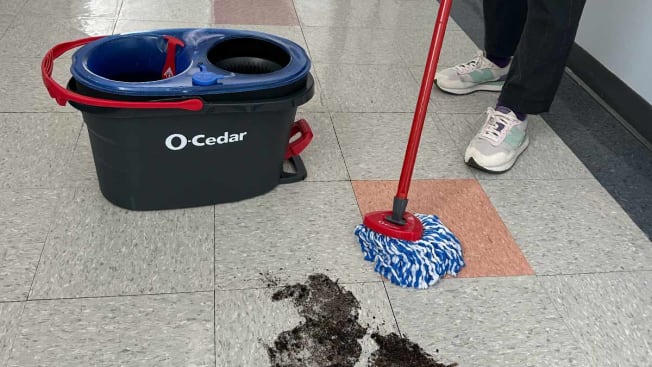
Photo: Consumer Reports Photo: Consumer Reports
The mop is safe to use on all hard floors, including hardwood, according to the manufacturer. The mop head can be machine-washed or hand-washed. Make sure you don’t use a fabric softener or bleach and lay it flat to dry afterward.
Pros
It’s excellent at absorbing messes. When it comes to absorption, the O-Cedar EasyWring RinseClean Spin Mop System won by a far margin. It took only one to four strokes to completely absorb the honey and Coca-Cola I had spilled on the floor. It was also way superior to the two other mops at mopping up dirt. It was able to pick up almost all the dirt except for the bigger chunks.
The bucket design is handy. I love the built-in pedal on the bucket. Before the O-Cedar, that was my negative association with string mops—the memory of squeezing dirty water from the mop using my bare hands. With the O-Cedar, all I had to do was step on the pedal, and the wringing was hand-free.
I also appreciated the bucket’s two-tank system. It made the process of cleaning easier because I was saved from the trip of having to go to a sink repeatedly to refill a bucket with clean water or wash my mop.
Cons
It’s bulky in size. Because it comes with a bucket, I found that the O-Cedar took up more space than the other two mops during my evaluation. If your home is smaller, this might be a tighter fit than the other two mops.
The bucket can be heavy to carry by hand. Carrying the bucket around while you’re cleaning can be tiring after a while, especially if you’ve filled it up with water to the maximum, as I did.
Bottom line: This is the mop to get if you want something that will deep-clean. I was especially astounded by its ability to mop up honey, leaving no trace of the sticky substance after only a few swipes. After evaluating all three mops, I found myself subconsciously reaching for the O-Cedar to do a final clean-up of the floors. It’s just that good.
The machine-washable mop head gains huge points, too, because it’s more eco-friendly than mops where you dispose of the mop head after cleaning. But if you live in a smaller space or want something more lightweight, the O-Cedar does have its drawbacks: It’s bulkier, and it can be cumbersome to carry the bucket around.
Where to Buy
Buy the O-Cedar EasyWring RinseClean Spin Mop System at Amazon, Home Depot, O-Cedar, Target, and Walmart.
Swiffer PowerMop
The Swiffer PowerMop is a spray mop that dispenses a cleaning solution when you press a button. For the PowerMop, you attach a pad to the mop head and throw away the pad once you’re done cleaning.

Photo: Consumer Reports Photo: Consumer Reports
It’s safe to use on many finished surfaces, including finished wood, luxury vinyl, tile, and laminate, according to the manufacturer. You shouldn’t, however, use it on unfinished, oiled, and waxed wooden boards, nonsealed tiles, and carpeted floors because they may be water-sensitive.
Pros
You don’t need a bucket or additional cleaning solution. I found it convenient, not having to lug around a bucket of water. Because the Swiffer PowerMop comes with its own cleaning solution, you also don’t need to buy any additional cleaning products.
It’s good at cleaning up liquids. The Swiffer PowerMop is great at absorbing liquids and cleaning off sticky substances such as honey, especially when the cleaning solution is employed. Without the cleaning solution, however, it takes more effort to mop up the honey than the O-Cedar EasyWring RinseClean Spin Mop System.
Cons
It’s not great at picking up dirt. Compared with the O-Cedar, it’s not proficient at absorbing messes such as soil. It can clean up some dirt, but not much. When I was using it, I felt like most of the time I was just pushing the dirt around, to little avail.
The mop pad sometimes falls off the mop. While using the mop, I found that the pad would sometimes have problems staying on the mop head, especially when I was carrying the mop around. The fact that I had to reattach the pad more than once made the mop seem flimsy.
You have to throw away the mopping pads. The manufacturer suggests that you throw away the pad every time you’ve done a cleaning. It’s fast if you don’t want to wash your mop, but it doesn’t seem environmentally friendly, not to mention the cost of refilling your mopping pad supply can add up over time.
Bottom line: It’s good at mopping up liquids, and when you use the cleaning solution, it’s on a par with the O-Cedar at cleaning up stickier messes. It’s more space-saving than the O-Cedar because it doesn’t require a bucket, so it might be well-suited for people who live in smaller homes.
For cleaning up dirt, however, it’s not as effective. I also dislike the fact that I have to throw away the pad whenever I’m finished mopping.
Where to Buy
Buy the Swiffer PowerMop at Amazon, Home Depot, Swiffer, Target, and Walmart.
Scrub Daddy Mop Daddy Butterfly Mop
It’s a sponge mop with a scrubbing strip in the middle. According to the manufacturer, it’s safe for all floor types, including wood, laminate, marble, and vinyl. The head can be detached from the mop and is machine-washable.
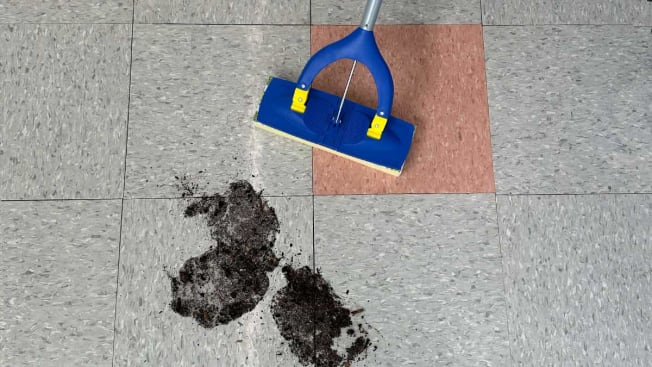
Photo: Consumer Reports Photo: Consumer Reports
Pros
It doesn’t take up much space. It’s lightweight and doesn’t take up much space. It’s also a pretty long mop with a handle that can be adjusted to 53 inches. To douse it with water, however, you’ll need to acquire an extra bucket on your own or run the mop underneath the faucet.
You can wring the mop without using your hands. I pulled a lever, which squeezed out the water in the mop without me having to dirty my hands. I liked the crisp motion of the wringing and how simple it was.
Cons
It’s only okay at cleaning. Compared with the other two mops, the Scrub Daddy Mop Daddy Butterfly Mop, frankly, just isn’t that effective at mopping up messes. It’s slightly less absorbent of liquids, though its performance is still decent. It requires more wipes and effort than the O-Cedar and the Swiffer to clean up stickier, more viscous substances like honey. And it’s as good as the Swiffer at picking up dirt. (Which isn’t that good.)
It’s not very maneuverable, comparatively speaking. The neck of the mop can be clicked at a 45-degree angle and a 90-degree angle to adjust for different cleaning areas. However, I found the process of adjustment to be less smooth than either the O-Cedar or the Swiffer, which swiveled much more easily.
Bottom line: Performance-wise, it pales compared with the other two mops. You can still clean with the Butterfly Mop, of course, but it requires more effort and isn’t as absorbent. Adjusting its different angles is also more of a process.
On the plus side, it’s lightweight and slim, ideal for storing. You don’t have to use your hands when you wring the mop dry, and the sponge is machine-washable rather than disposable, making it less wasteful.
Where to Buy
Buy the Scrub Daddy Mop Daddy Butterfly Mop at Scrub Daddy and Target.
How to Mop Your Floors Correctly
If you want your floors to be sparkling clean, a good mop can only take you so far if you don’t have the right technique. I asked cleaning experts for tips on how to best mop their floors. Here’s what they said.
Vacuum or sweep first. Before you even begin mopping, you should clean any large dirt and debris from the floor. It’s one of the most common mistakes people make.
“It’s like ice skating with rocks in your shoes,” says Jennifer Rodriguez, the chief hygiene officer of cleaning service company Pro Housekeepers. Not vacuuming or sweeping beforehand just makes mopping less effective.
Pick the right mop for the job. Microfiber mops are ideal because they pick up everything, Rodriguez says. For deep cleaning, string mops work the best, and flat microfiber mops are suitable for the smaller cleaning sessions in between, says Angie Hicks, co-founder of home services website Angi.
Choose your cleaner according to the floor type. For laminate and vinyl floors, avoid soap-based detergents. You can use a homemade solution of ½ cup of vinegar mixed with 1 gallon of water. For hardwood floors, it’s usually best to stick with a mild non-acidic floor cleaner, Hicks says.
Different floor types need different types of cleaners, so if you’re in doubt, check the manual or label, Rodriguez says.
Don’t use too much water. Wring your mop out thoroughly before you start mopping. Be careful not to use too much water for wood floors because that could warp the hardwood. The same goes for linoleum floors, which also warp easily, Hicks says.
Speaking of water, you should freshen the water while you’re mopping. Also, make sure to wash your mop in the process. Otherwise, it’s just a dirt paintbrush, Rodriguez says.
Follow these steps for mopping. Start mopping at the far end of your room because you don’t want to leave footprints on a freshly mopped floor. If you’re using a string mop, make figure-eight motions. For sponge and flat microfiber mops, go in straight lines and with the grain of your floor, Hicks says. And finally, let the floor thoroughly dry before you step on it.
How We Evaluated the Mops
I poured damp soil, Coca-Cola, and honey on the surface of different floor types, including linoleum, laminate, and porcelain tiles, and then I judged the mops on the following aspects.
Performance
I looked at how well the mops cleaned up the messes and how many strokes it took. After the floors were mopped, I also used a paper napkin to see if residue was left behind.
Ease of Use
I evaluated how easy the mops were to use and maneuver during cleaning.
Washing and Maintenance
I considered elements such as whether the mop heads were disposable or washable. And if they’re washable, how easy are they to wash, and can they be put in a washing machine?

